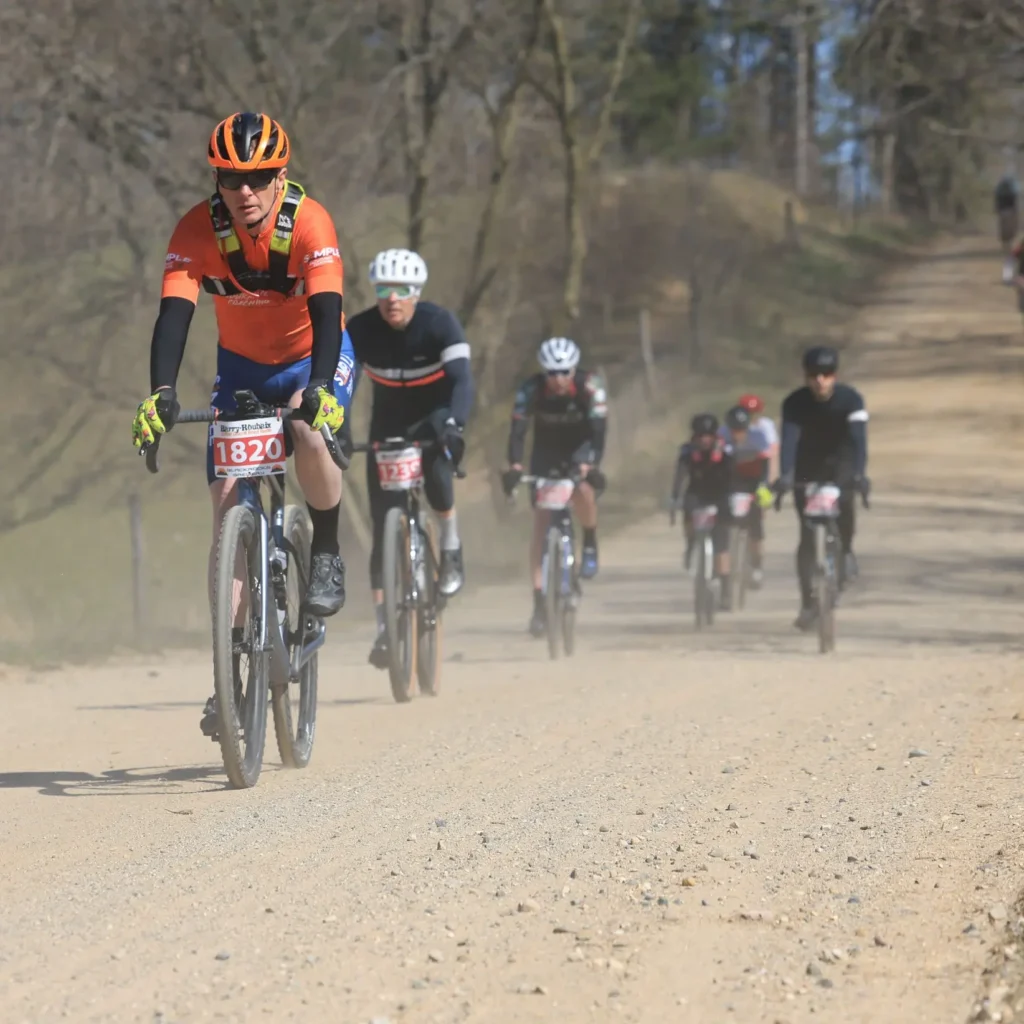
Breathe with Your Feet: What Science Says About Syncing Breaths to Running Cadence (and How to Train It)
By Coach Nicole Ford
Three Things to Know About Breathing Cadence When You Run
- Many runners naturally “lock” their breath to their steps—this is called locomotor–respiratory coupling (LRC). It’s common, robust, and likely useful.
- Evidence suggests LRC can lower perceived breathlessness and may improve economy in some settings, but the size of the performance benefit in running is modest and individual.
- Using odd step ratios (e.g., 3:2—three steps inhale, two steps exhale) alternates which foot hits the ground as you start each exhale and may reduce side-stitch risk. This was the most interesting suggestion in the research that I’ll practice getting ready for cyclocross.
What the research says
LRC (locomotor–respiratory coupling) is real and common.
Runners often coordinate breathing to stepping at integer ratios (e.g., 2:2, 3:2).
Reviews and experiments suggest this coupling arises from both mechanical and neural interactions and shows up across intensities.
It’s robust—even when you’re tired or conditions change. One study suggests that trained runners maintained LRC after a respiratory-muscle fatigue challenge and even at simulated moderate altitude, suggesting the brain–body system “prefers” entrainment during running.
Why might it help? Coordinating steps and breaths can reduce antagonistic loading on breathing muscles and may make the work of breathing easier.
Antagonistic loading means that when you run, each foot strike creates impact forces that travel through your core.
If your breathing is out of sync with your steps, those impact forces can hit when your diaphragm is trying to contract or relax, which makes it work harder—almost like pushing a swing in the opposite direction.
Does it improve economy or performance? Evidence is mixed. Some work (mostly in walking and other rhythmic exercise) links tighter coupling to lower oxygen cost; in trained runners, attention cues don’t seem to change LRC much, and any economy effect appears small and individual. Bottom line: LRC is a tool for comfort and rhythm, not a magic bullet.
Can you learn it? Yes. Lab work shows novices can be guided to stable LRC with cues from an app.
Practical implications for everyday runners
- Use LRC to smooth your breathing, not to force a pace. If syncing calms your breathing and lowers the “air hunger,” keep it. If you feel tense or choppy, loosen the pattern.
- Favor odd ratios when possible. At easy–moderate efforts, 3:2 (5 steps per full breath) often feels natural and alternates the exhale footstrike—potentially reducing side-stitch risk. At faster paces, many drift toward 2:2 or 2:1—that’s okay; just don’t get rigid.
- Expect individual differences. Trained runners tend to self-organize coupling that works for them; there’s no single “best” ratio.
- Don’t chase ratios during races. Use them as a calming tool if you get ragged, then return to feel. Over-focusing can backfire.
How to practice
Before you start: On an easy run, count your steps and breaths for 30 to 60 seconds to see where you naturally sit (e.g., about 170 to 180 spm with about 30 to 45 breaths/min at endurance pace).
Drill 1: The 3:2 Finder (easy–moderate days)
- Inhale for 3 steps (L-R-L), exhale for 2 (R-L), then repeat.
- Do 4 x 2 minutes “locked in,” 1 minute relaxed, for 10–15 minutes.
- If you feel tight, broaden the inhale (use the belly) and soften your shoulders.
Why: Alternates the foot at the onset of exhalation and often feels smooth at aerobic paces.
Drill 2: Gear Shifts with Ratios
- Run 3–4 “gears” for 2 minutes each at: easy → steady → tempo.
- Let the ratio naturally shift (e.g., 3:2 → 2:2 → 2:1).
The cue is “light feet, long exhale”—don’t force counts if form degrades.
Why: Shows you how coupling adapts with intensity so you can stay relaxed.
Drill 3: Cadence-Aware Hill Repeats
- Short hill reps (45 to 60s). Aim to keep the exhale steady as the cadence rises.
- Count only exhales (e.g., three exhales per rep) to avoid overthinking.
Why: Trains stable breathing under changing mechanics (grade/cadence).
Drill 4: Metronome/Music Assist (optional)
- Use ~170–180 bpm tracks or a metronome and layer your 3:2 or 2:2 pattern over the beat for 5–10 min mid-run. I often use the beat in the music from Podrunner.
Why: External rhythm can help novices train steps and breaths.
Side-stitch fix
- If a stitch starts, switch to an odd ratio (e.g., 3:2) and try to start the exhale on the opposite foot from where it’s hitting. Slow slightly, deepen the exhale for four to six breaths.
Need more?
Unlock the secrets to mastering gravel racing with our FREE Guide to Gravel Racing! Get yours here.
BOOK A CALL so we can discuss your goals, answer questions, and talk about making your endurance training more effective, fun, and Simple.
Paul Warloski is a:
- USA Cycling Level 1 Advanced Certified Coach
- RRCA Running Coach
- Training Peaks Level 2 Coach
- RYT-200 Yoga Instructor
- Certified Personal Trainer
- Certified Nutrition Advisor




